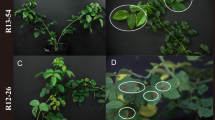Abstract
Transgenic tobacco plants expressing an inhibitor of ubiquitin-dependent protein degradation, ubiquitin variant ubR48, spontaneously formed necrotic lesions and displayed altered responsiveness to tobacco mosaic virus attack. These plants were analyzed for the accumulation of defense-related compounds and the expression of pathogenesis-related proteins, which serve as convenient markers for systemic acquired resistance. Callose was detected in the cells of vascular bundles and in the leaf blade. In addition, ubR48 transgenic plants constitutively accumulated enhanced levels of salicylic acid (SA) and/or its glucoside. Accumulation of SA glucoside coincided with high levels of pathogenesis-related protein 1, underscoring the similarity of certain changes in ubR48-expressing plants to an authentic defense reaction.
Similar content being viewed by others
Author information
Authors and Affiliations
Additional information
Received: 8 December 1997 / Revision received: 25 February 1998 / Accepted: 15 March 1998
Rights and permissions
About this article
Cite this article
Conrath, U., Klessig, D. & Bachmair, A. Tobacco plants perturbed in the ubiquitin-dependent protein degradation system accumulate callose, salicylic acid, and pathogenesis-related protein 1. Plant Cell Reports 17, 876–880 (1998). https://doi.org/10.1007/s002990050501
Issue Date:
DOI: https://doi.org/10.1007/s002990050501




